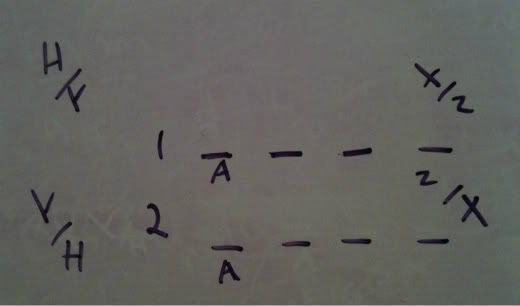LSAT Forum
2 postsPage 1 of 1
-

- timmydoeslsat
-
Thanks Received: 887
-
Atticus Finch

- Posts: 1136
- Joined: June 20th, 2011

- Most Thanked

- First Responder
Re: Q18
I will go through the steps and decisions I made when I just did this problem.
The local rule is that H and Y are in different boats. Which boats must go in boat 1.
First, it is helpful to know what the tendencies of the test are. In a grouping game like this with the conditionals given, we know it will somehow play off of this.
I created a set up for this question.

Notice that not only on this question, but in general, the idea of x and z being in different boats is something we can use to our advantage.
Both are children. Both have no other rules governing them other than that fact. They are interchangeable. For this question, you could wipe those slots off of the board! They have no impact.
OK, I think about what are the limiting factors in this game. It is the adults! And I noticed when I first looked at this game that we could have issues if F does go second. That would bring along another adult in G into boat 2. That would force H into 1.
This test rewards critical thinking.
I know that if I place F into boat 1, I am not left with great "necessary" conclusions I can draw upon. I mean, I could put G with it, or I could choose not to. I want something that gives me certainty in an uncertain situation.
I know that if I put F into 2, I have a rule with it. I must put G into 2. I then know, for certain, that H must go in 1. That, for certain, puts Y into 2. Boat 2 filled up.
Boat 1 has two slots left. V and W. We know that when V is in one, then W is in two. This scenario could never work.
We know F must be in 1.
The local rule is that H and Y are in different boats. Which boats must go in boat 1.
First, it is helpful to know what the tendencies of the test are. In a grouping game like this with the conditionals given, we know it will somehow play off of this.
I created a set up for this question.

Notice that not only on this question, but in general, the idea of x and z being in different boats is something we can use to our advantage.
Both are children. Both have no other rules governing them other than that fact. They are interchangeable. For this question, you could wipe those slots off of the board! They have no impact.
OK, I think about what are the limiting factors in this game. It is the adults! And I noticed when I first looked at this game that we could have issues if F does go second. That would bring along another adult in G into boat 2. That would force H into 1.
This test rewards critical thinking.
I know that if I place F into boat 1, I am not left with great "necessary" conclusions I can draw upon. I mean, I could put G with it, or I could choose not to. I want something that gives me certainty in an uncertain situation.
I know that if I put F into 2, I have a rule with it. I must put G into 2. I then know, for certain, that H must go in 1. That, for certain, puts Y into 2. Boat 2 filled up.
Boat 1 has two slots left. V and W. We know that when V is in one, then W is in two. This scenario could never work.
We know F must be in 1.
2 posts Page 1 of 1